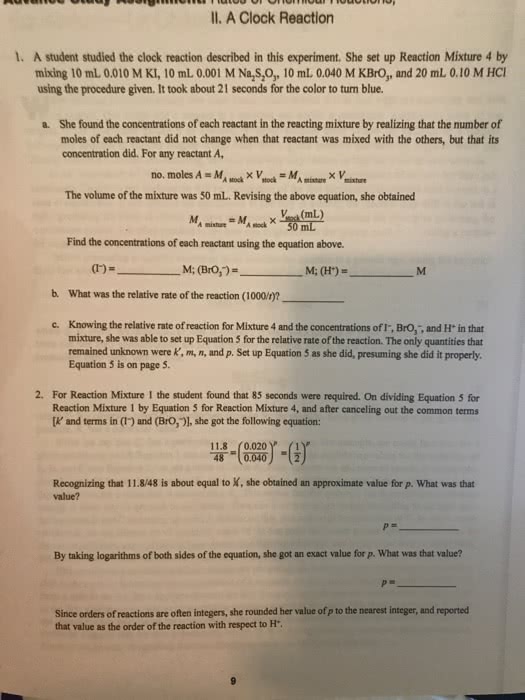<p>1. A student studied the clock reaction described in thisexperiment. She set up Reaction Mixture 3 by mixing 10mL 0.010M KI,10mL 0.0010M Na2S2O3, 20mL 0.04 M KBrO3, and 10mL 0.10M HCl usingthe procedure given. It took about 40 seconds for the color to turnblue.</p>
<p><br />a. She found the concentrations of eachreactant in the reacting mixture by realizing that the number ofmoles of each reactant did not change when that reactant was mixedwith the others, but that its concentration did. For any reactantA,</p>
<p>                         nomoles A= M (A stock) X V (stock)= M (A mixture) XV (mixture)</p>
<p>         The volume of the mixture was 50mL. Revising the equation, sheobtained</p>
<p>                         M(A mixture)= M (A stock) X (V (stock)/ 50mL)</p>
<p>         Find the concentrations of each reatant by using theabove equation.</p>
<p>                    (I-)=_________M; (BrO3-)=________M; (H+)=_________M</p>
<p>b. What was the relative rate of teh reaction(1000/t)?____________</p>
<p>c. Knowing the relative rate of reaction for Mixture 3 andthe concentrations of I-, BrO3-, and H+ in that mixture, she wasable to set up Equation 5 for the relative rate of the reaction.The only quantities that remain unknown were k', m, n, and p. SetEquation 5 as she did, presuming she did itproperly.</p>
<p>Equation 5:  relative rate= k'(I-)^m(BrO3-)^n(H+)^P</p>
<p> </p>
<p>2. For reaction Mixture 1 the student found that 75seconds were required. On dividing Equation 5 for Reaction Mixture1 by Equation 5 for Reaction Mixture 3, and after canceling out thecommon terms (k', terms in (I-) and (H+)), she got the followingequation:</p>
<p>                                         13.3/25= (0.0040/0.0080)^n=(1/2)^n</p>
<p>Recognizing that 13.3/25 is about equal to 1/2, sheobtained an approximate value for n. What was thatvalue?</p>
<p>                                                                                                                                     n=________</p>
<p>By taking logarithms of both sides of the equation, shegot an exact value for n. What was that value?</p>
<p>                                                                                                                               n=_________</p>
<p>Since orders of reaction are often integers, she reportedher approximate value as the order of the reaction with respect toBrO3-.</p>
<p> </p>
<p>1. A student studied the clock reaction described in thisexperiment. She set up Reaction Mixture 3 by mixing 10mL 0.010M KI,10mL 0.0010M Na2S2O3, 20mL 0.04 M KBrO3, and 10mL 0.10M HCl usingthe procedure given. It took about 40 seconds for the color to turnblue.</p>
<p><br />a. She found the concentrations of eachreactant in the reacting mixture by realizing that the number ofmoles of each reactant did not change when that reactant was mixedwith the others, but that its concentration did. For any reactantA,</p>
<p>                         nomoles A= M (A stock) X V (stock)= M (A mixture) XV (mixture)</p>
<p>         The volume of the mixture was 50mL. Revising the equation, sheobtained</p>
<p>                         M(A mixture)= M (A stock) X (V (stock)/ 50mL)</p>
<p>         Find the concentrations of each reatant by using theabove equation.</p>
<p>                    (I-)=_________M; (BrO3-)=________M; (H+)=_________M</p>
<p>b. What was the relative rate of teh reaction(1000/t)?____________</p>
<p>c. Knowing the relative rate of reaction for Mixture 3 andthe concentrations of I-, BrO3-, and H+ in that mixture, she wasable to set up Equation 5 for the relative rate of the reaction.The only quantities that remain unknown were k', m, n, and p. SetEquation 5 as she did, presuming she did itproperly.</p>
<p>Equation 5:  relative rate= k'(I-)^m(BrO3-)^n(H+)^P</p>
<p> </p>
<p>2. For reaction Mixture 1 the student found that 75seconds were required. On dividing Equation 5 for Reaction Mixture1 by Equation 5 for Reaction Mixture 3, and after canceling out thecommon terms (k', terms in (I-) and (H+)), she got the followingequation:</p>
<p>                                         13.3/25= (0.0040/0.0080)^n=(1/2)^n</p>
<p>Recognizing that 13.3/25 is about equal to 1/2, sheobtained an approximate value for n. What was thatvalue?</p>
<p>                                                                                                                                     n=________</p>
<p>By taking logarithms of both sides of the equation, shegot an exact value for n. What was that value?</p>
<p>                                                                                                                               n=_________</p>
<p>Since orders of reaction are often integers, she reportedher approximate value as the order of the reaction with respect toBrO3-.</p>
<p> </p>

